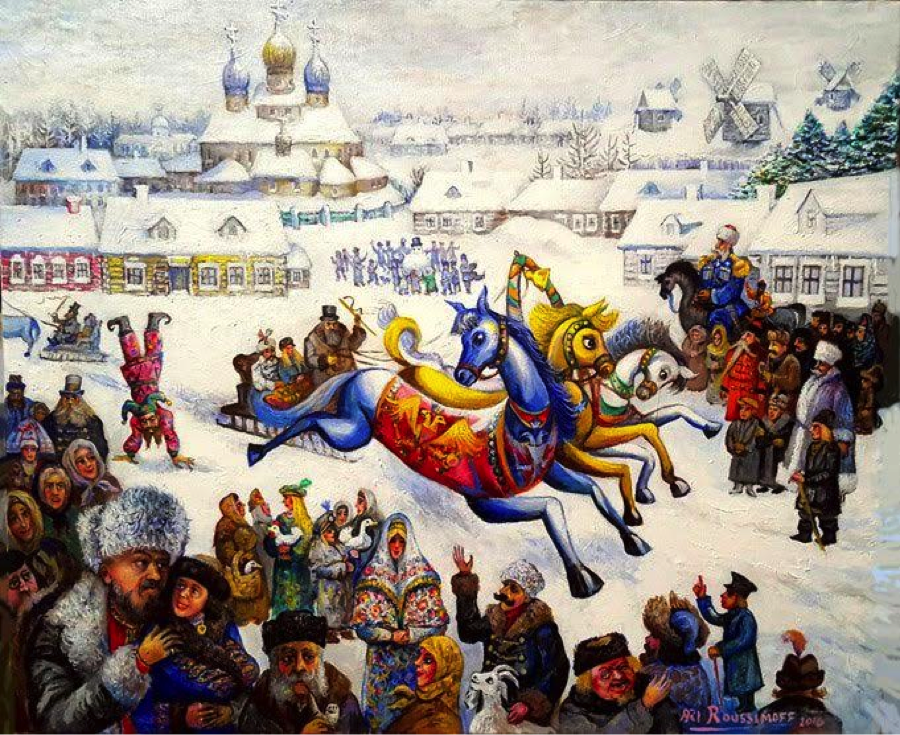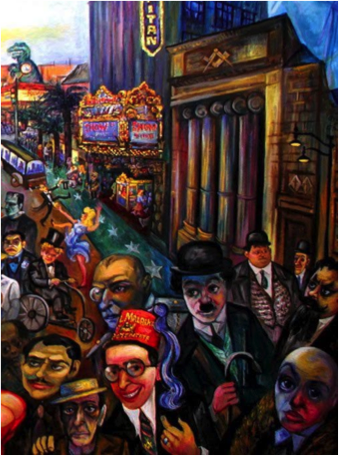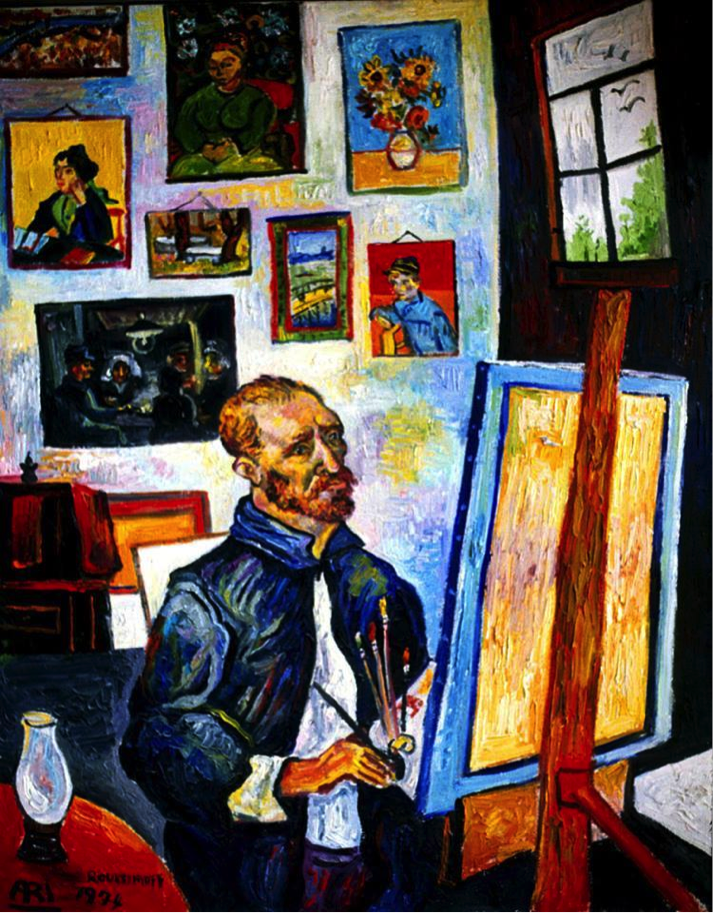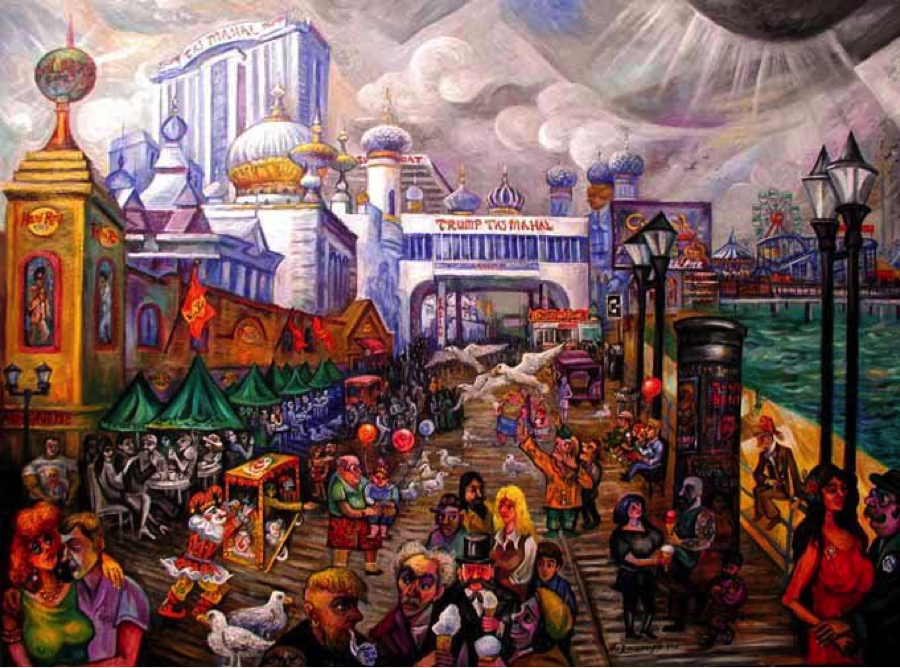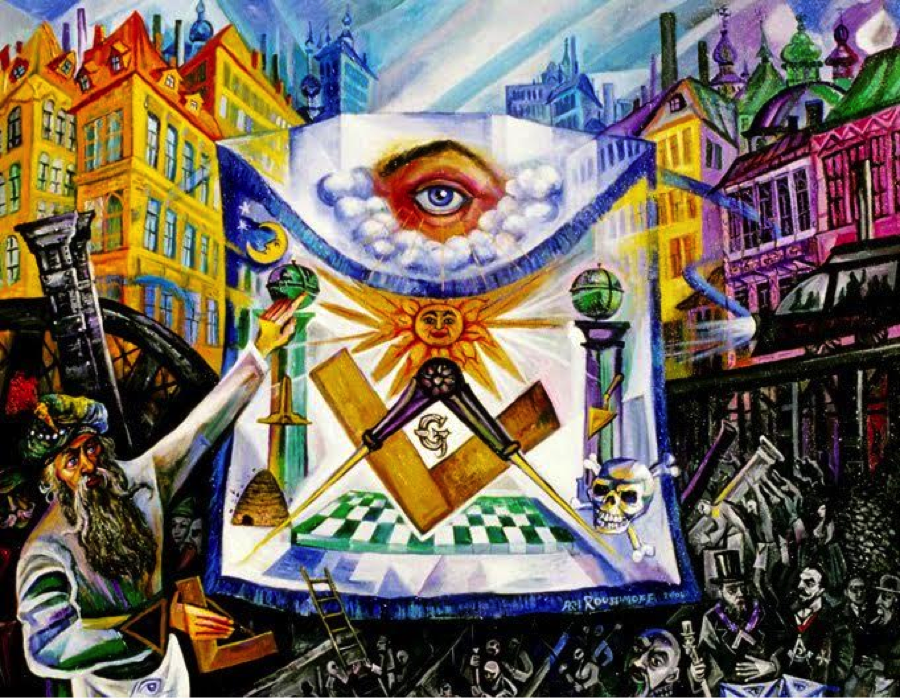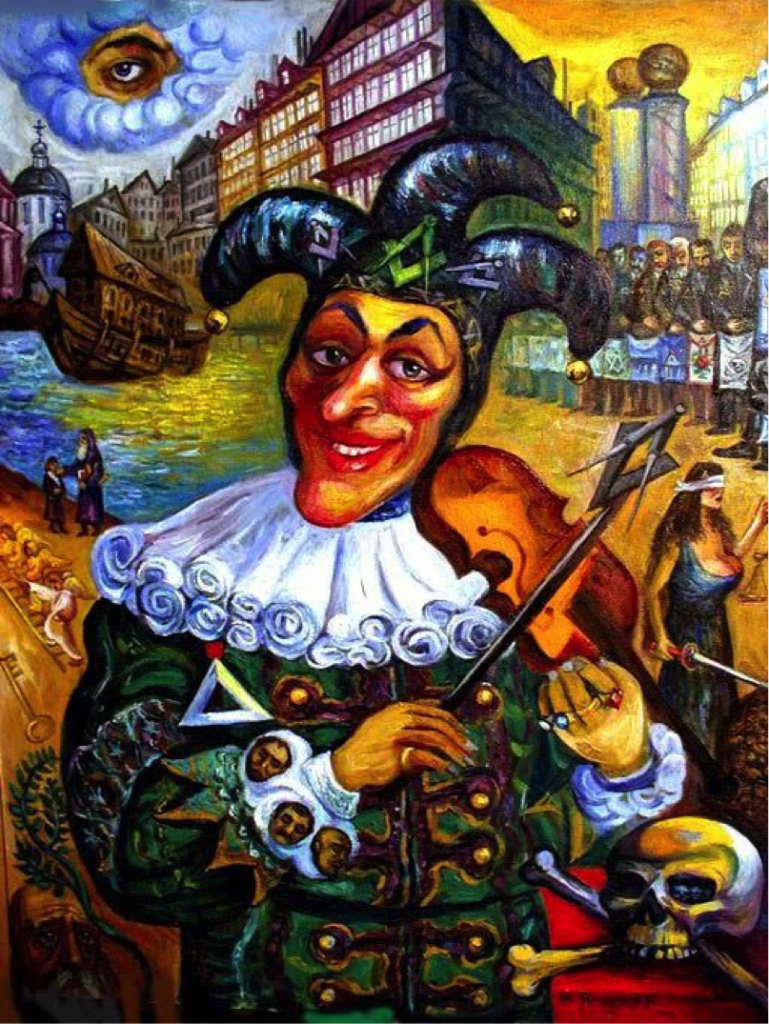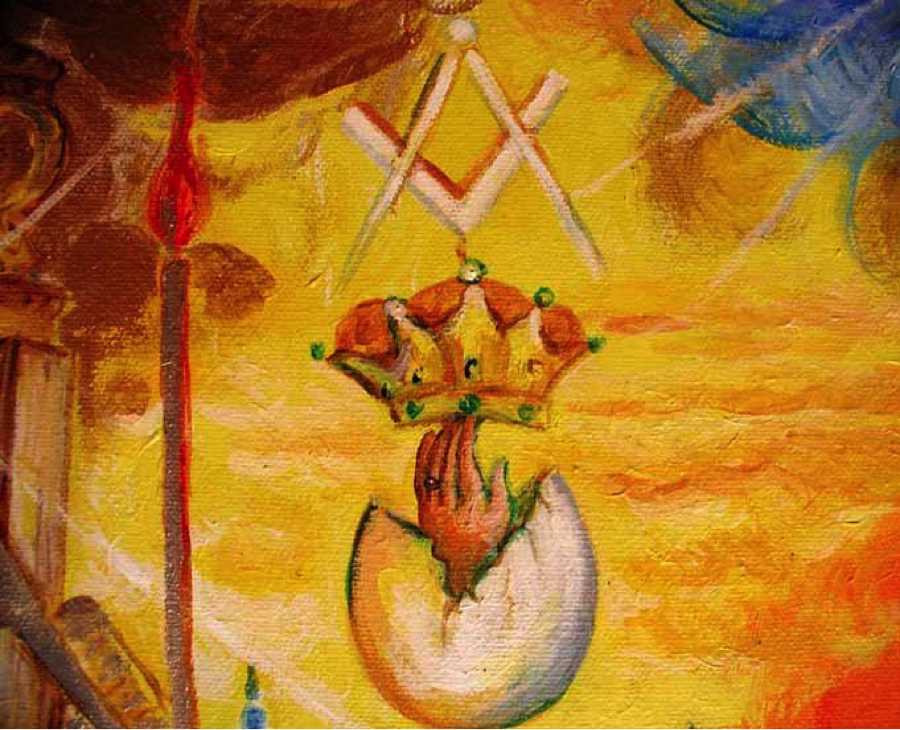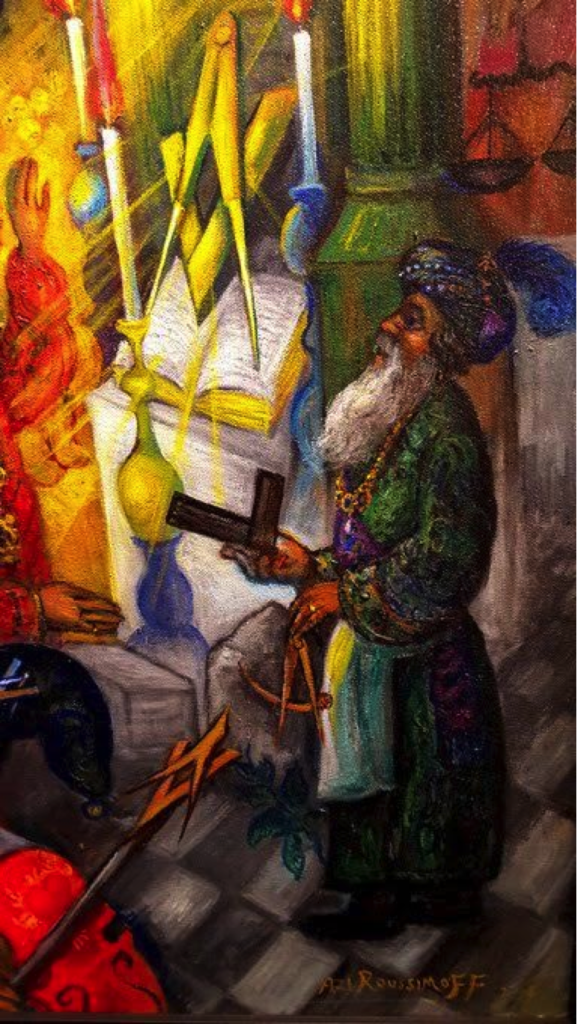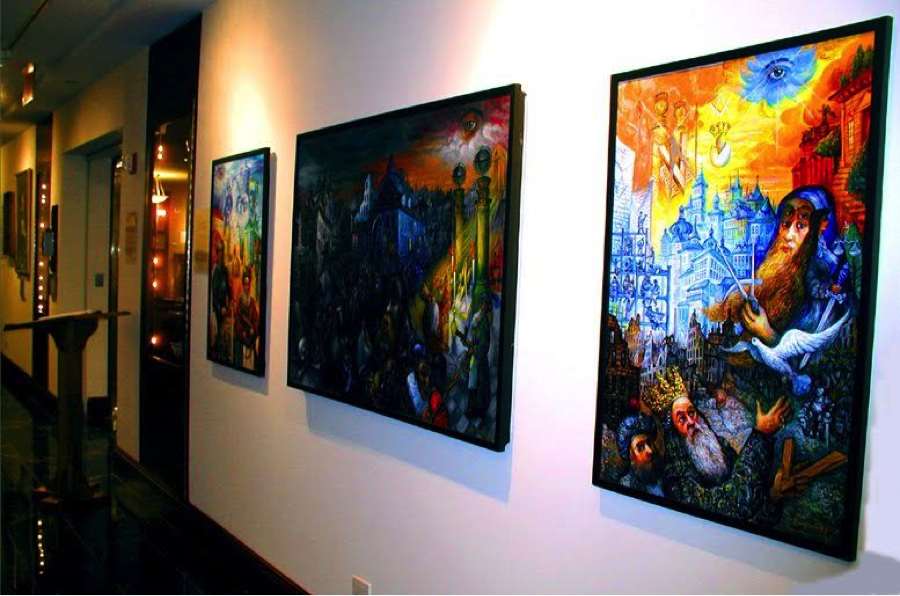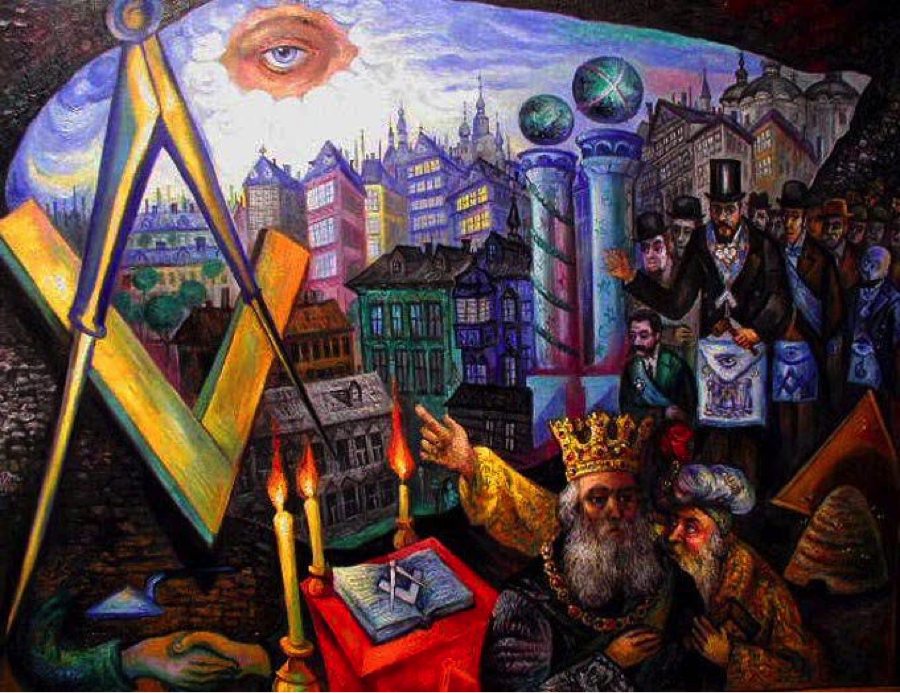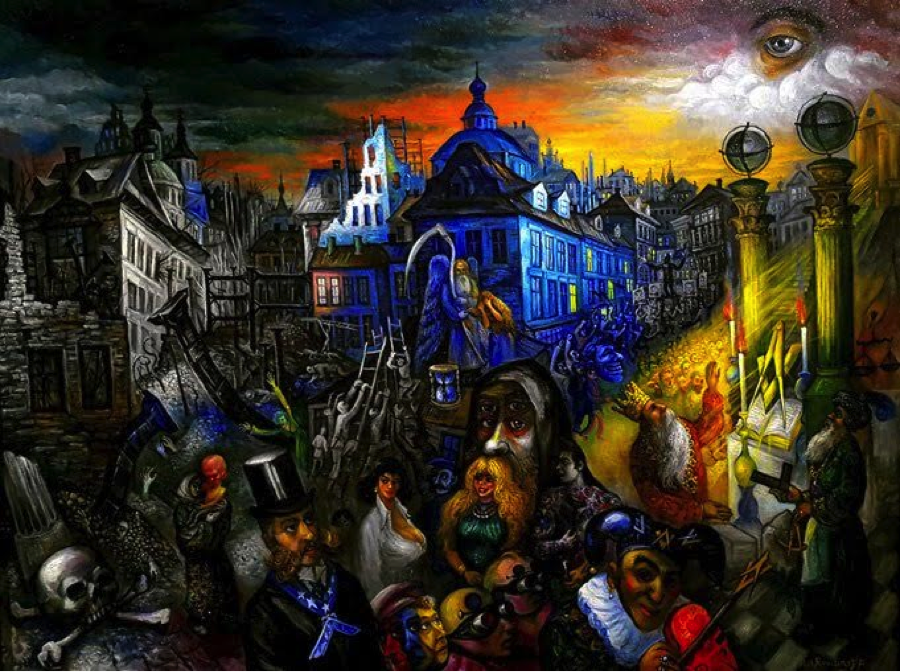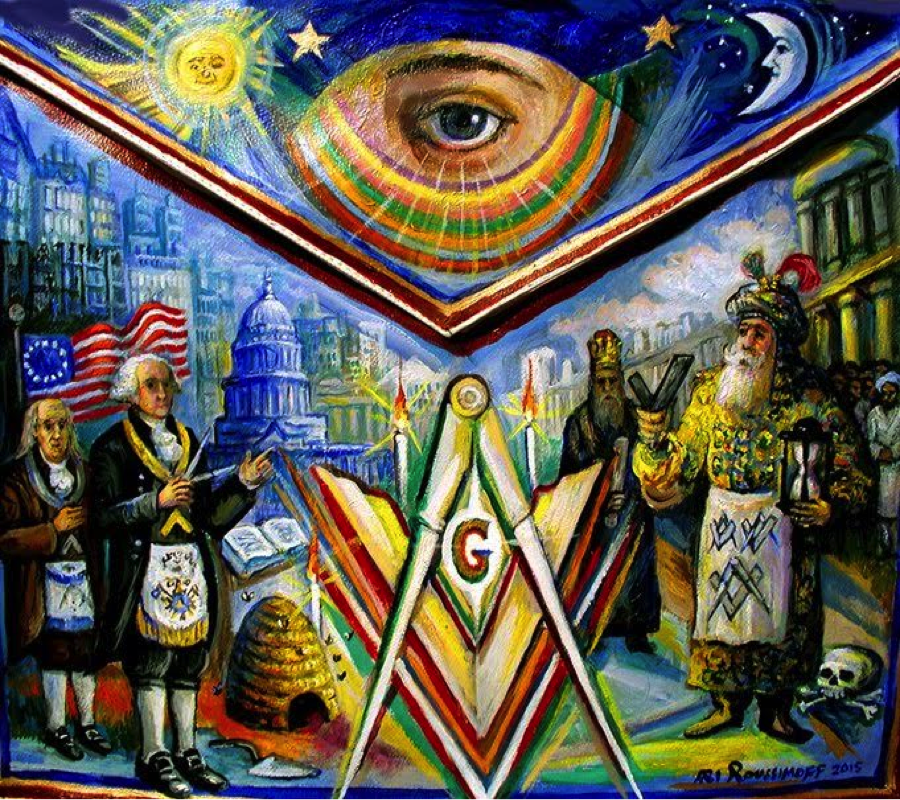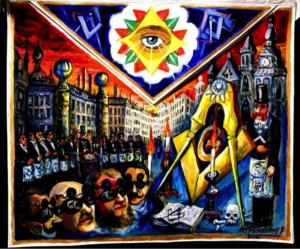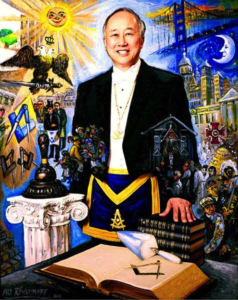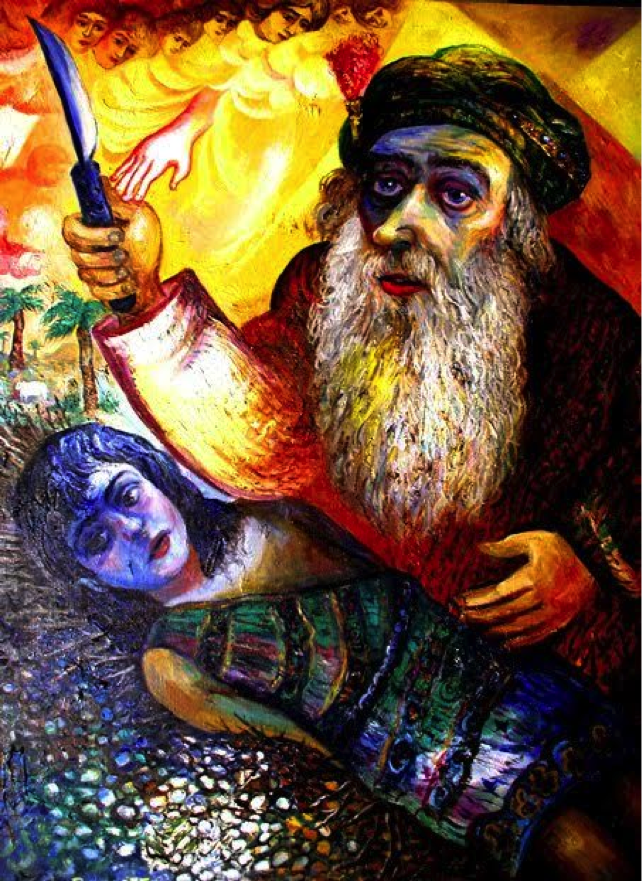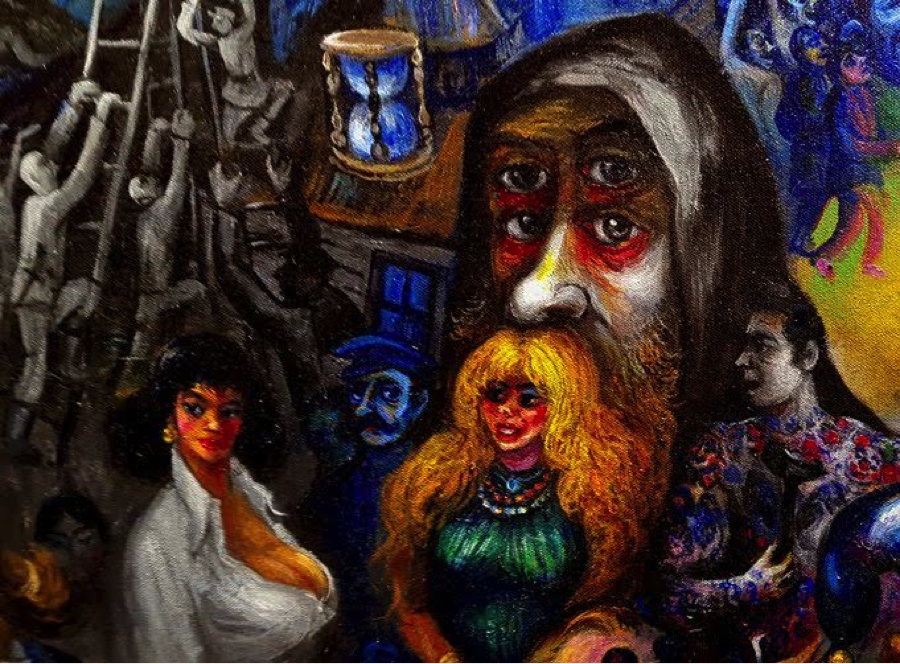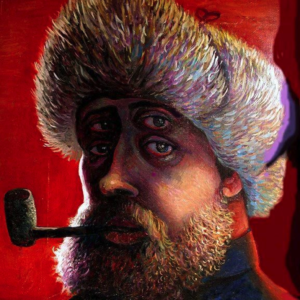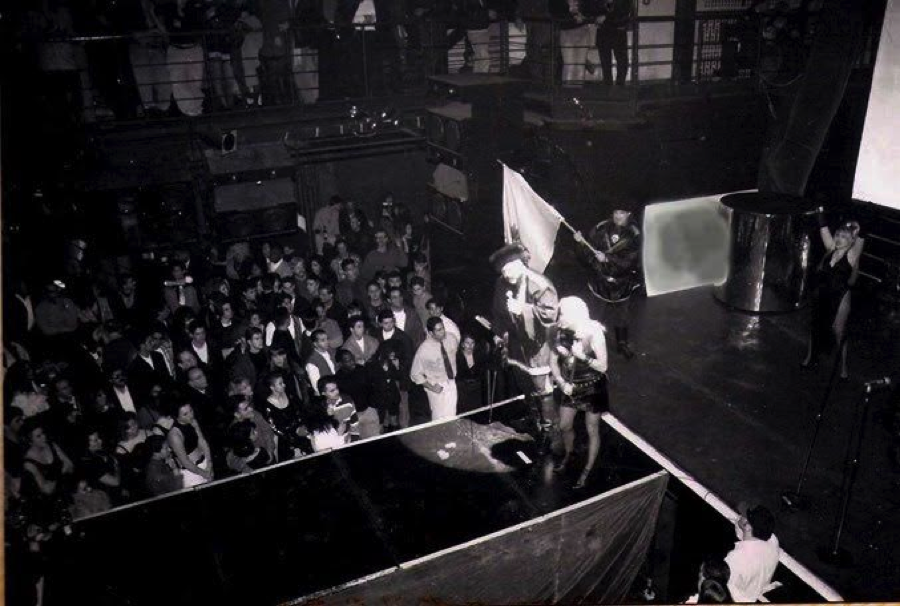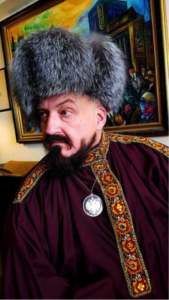
Photograph January 2016
By Vivian Forlander
Phoenixmasonry is thrilled to have had the opportunity to interview the multi-talented artist, Ari Roussimoff. His Masonic themed paintings are phenomenal, as are his painted Masonic Aprons through which he hopes to revive an interest in the largely lost art form. It is our hope that Masons and non-Masons alike will take an interest in his work, if they haven’t done so already, as it is well worth the time!
Ari Roussimoff’s art has been shown in places such as The Metropolitan Museum of Art, The Nicholas Roerich Museum, and the Chancellor Robert R. Livingston Masonic Library and Museum. Ari’s paintings are colorful, daring, culturally rich, spiritually rounded, geometrically stunning, and a clear reflection of a profound character.
Elena Llamas, Director of Public Relations for Phoenixmasonry (EL): Thank you, Ari, for this interview. Please tell us about your background.
Ari Roussimoff (AR): Thank you, Elena, for inviting me. I have been impressed for years with the Phoenixmasonry site and what it is doing to promote the culture and history of Freemasonry. As to my background, I am one of those people who cannot be pinned down to one specific place. My family and ancestors have lived in Russia, Ukraine, Poland and even Moldavia among other countries. Although I was born in Germany, the Russian and other East European cultures have always been close to my heart, as much of my artwork reflects this.
Literature, music and art were on the daily menu in my home. Over the years I have been privileged to live and work in both Europe and America.
EL: Where do you feel most at home?
AR: For the most part, I am at home inside my head and also in my heart. But certain places are quite special to me.
In Europe, Zürich, Switzerland where Mother Nature is at its finest, Amsterdam, Holland with its great collections of Old Master paintings. Any place Rembrandt lived is great.
In the United States, Miami Beach, Florida with its vivid, tropical color is fabulous. I painted its festive carnivals, cafes and crowds. Sometimes I’d even add a little nod to Freemasonry.

For example, in my panoramic Beach Café painting, I included a merry group of Shriners crossing the street while nearby stands a bearded lady holding her little son’s hand.
Another favorite place is Southern California. When based in San Diego, I’d visit Hollywood and fantasize about the great historic film world of days gone by.
A painting I did of Hollywood Boulevard features many of the classic movie stars congregating in front of the old Masonic Temple (now a television studio where they film the Jimmy Kimmel show).
Featured in the very front of my picture is silent movie legend Harold Lloyd wearing his Imperial Potentate’s Al Malaikah Shriner Fez. There are other masons in there as well: Harpo Marx, Clark Gable, John Wayne and Oliver Hardy.
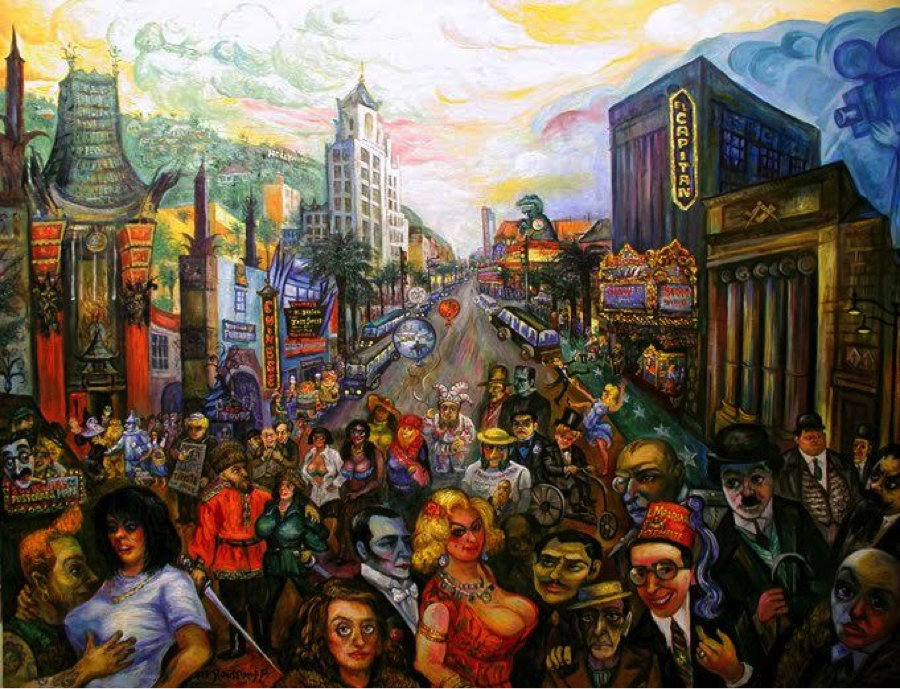
EL: When and how did you first become interested in art?
AR: My father was a writer. So I grew up in a cultural European household. The first artist that spoke to me was Van Gogh. I discovered him at age seven when watching a television documentary devoted to his life and work. Van Gogh became an early passion.
Since then, I’ve collected many books on him and have hunted down his paintings in museums throughout the world.
At fourteen I discovered Rembrandt. My second passion in art. By the way, I started drawing at age three and did my first oil at seven.
[I] also started to exhibit as a child. Luckily, I had parents who supported my love of art.
EL: How wonderful! Did any current or artist in particular inspire or influence your work?
AR: As an artist, you become a sponge of sorts, soaking up influences from many sources. My breath is taken away by the Old Masters. Rembrandt, Leonardo da Vinci, Rubens, the list is endless. Leonardo was the ultimate artistic genius. Each of his paintings are hypnotic.
Some of my other loves include Byzantine art, Russian and other folk arts, Van Gogh and numerous of the moderns. Too many to mention.
“This photograph of me was taken around 1990. Salvador Dali once said that an artist should look like his work. Sounds fine to me. In this photo, I am holding a 19th century Italian Paper Mache Commedia dell’arte mask. The coat I am wearing was once worn by the great Russian Opera singer Feodor Chaliapin. He wore the coat while performing as Ivan the Terrible in Rimsky-Korsakov’s Opera, “The Maid of Pskov” in Paris. I cherish this coat with its unique theatrical history.”
– Ari Roussimoff
EL: And as a teenager, you were invited to lunch with Salvador Dali and his wife Gala. What was that like?
AR: At the age of fourteen I was being managed by Theodore Karr, a representative of the Shorewood Art publishing company, a noted publisher of lithographs by some of the greatest artists in Europe.
A meeting was arranged for me to meet the great master Dail for lunch at a restaurant in the Hotel St. Regis in New York, where he lived for half the year. Our small group consisted of Dali, his wife Gala, Mr. Karr, my father and myself. Naturally I was very nervous when introduced to Dali. My knees were trembling. Surprisingly, Dali’s personality was completely different from the “crazed” image he promoted. Handsomely dressed in a three piece suit, holding a beautiful cane, Dali was polite, soft spoken and to me, he seemed a bit sad.
Then there was Gala. There was a quiet, but hostile dynamic going on between Dali and his wife. Dali’s command of English was far better than how he presented himself during filmed interviews. Oddly enough, he talked mostly about movies. He liked Hitchcock and John Wayne films. Early on Dali had collaborated with the Spanish surrealist filmmaker Luis Buñuel on two avant garde movies and in later years he worked for Alfred Hitchcock in designing a scene for “Spellbound.” Dali told us he hoped to yet do another film. Toward the conclusion of our lunch, Dali pulled out a portfolio from which he gifted me a signed artist’s proof lithograph. A man in the restaurant had recognized Dali and approached our table to ask for an autograph. Immediately, Dali turned into the eccentric madman he usually portrayed. He propped himself up, soldier like. His eyes bulged and his voice became amplified, with his language having changed into the familiar chaotic Dalinian jargon of English-French-Spanish. He graciously complied and gave the man an autograph. Upon the man’s retreat back to his table, Gala shot up off her chair and berated her husband loudly in French. Customers in the restaurant were glaring. Quite embarrassing! After we left the place, Mr. Karr attempted to explain that Gala’s rant, saying that she resented Dali drawing attention to himself, creating a spectacle. That pretty much describes my encounter with Salvador Dali.
EL: That’s an amazing story! Thank you for sharing it with us, tell us about your relationship with Masonry.
AR: I have always appreciated the great achievements of humanity while also being very much aware of the shortcomings. There isn’t a thing about the human condition that cannot be found in the Bible. Since much of my way of thinking is of biblical origin, I understood that humanity was given the ability by God to rise up to advance itself and achieve wonders to benefit one’s self and mankind.
Art played a significant role in leading me toward Freemasonry. I never felt Art was limited to esthetics. For me it became an expression of the soul. Art is a universal language. French, German, Spanish, Greek, Russian, Polish or African. Any genuine work of art transcends its ethnic origins, and translates into a universal language that speaks to all.
Walking through the streets of Los Angeles, New York and through Europe, my eye often fixated on old buildings that incorporated mystical looking designs. Often I wondered if these were Masonic decorations. My curiosity about Freemasonry started taking form.
I began to read up on the subject and absorb the philosophy and the rich culture accompanying it. What struck me early on is that some of the iconography I had known from early Christian art, such as the All Seeing Eye of God was an important essential component of Freemasonry, as is the Holy Bible. Then I was surprised to recognize similarities between Masonic symbolism and some of the mystical imagery that had been appearing in my own pictures for years.
Fascinated with the moral philosophies of Freemasonry, I was awed by the abundance of illustrious members, the great philosophers, leaders, authors, artists, musicians, philanthropists, scientists, inventors, poets, physicians. Mozart, Goethe, Voltaire, George Washington, Benjamin Franklin, Booker T. Washington, Kaiser Wilhelm I, Sir Arthur Conan Doyle, Pushkin, Oscar Wilde, Mark Twain. In my triptych that currently hangs in the Livingston Library there is a tribute to quite a few illustrious individuals who have been Masons.
Just a matter of note, in comparison to music, literature and entertainment, there were relatively few artists who were Masons.
There were numerous fine engravers. The most important sculptors and painters included Bartholdi, Hogarth, Mucha, Grant Wood, the great German expressionist Lovis Corinth (who did illustrations of lodge ceremony) and the Cubist master Juan Gris (he served as Master of his Lodge in Paris).
My keen interest eventually led me to the point where I wanted to do a film on Freemasonry. With that project in mind, I visited the wonderful Chancellor Robert R. Livingston Masonic Library & Museum of the Grand Lodge of New York in Manhattan. Their collection of materials is awesome. And everything was generously put at my disposal for study. This was in 2002. Although this particular film project has not as yet materialized, this was my road to joining. It has been an ever inspiring journey.
EL: Your work is a very skilled and inspiring contribution to the smaller body of Freemasonic art. Currently, you have art on display inside the Grand Lodge of New York building. Is there anything you would like to share about the exhibition?
AR: Yes, my paintings called Hiram’s Apron and King Solomon’s Vision, which have become widely known, were the first to be exhibited at the Livingston Masonic Library & Museum.
Currently, the museum is displaying my triptych titled Parable Of Light and Dark which consists of three paintings, which tell a symbolic story about Freemasonry through the past, present and an eye toward possibilities for the future. The first piece is called Foundations. It depicts the beginnings of Freemasonry, starting with Hiram and the building of the Holy Temple. The composition then moves upwards to Medieval times with Knighthoods and Cathedrals paving the way towards modern times.
At the very top in Foundations, I depict art and culture with portraits of Mozart, Mark Twain, Oscar Wilde, Pushkin and Voltaire.
The middle painting is called Eclipse. The idea behind ‘Eclipse’ is that within any darkness, there is a light of inspiration that can, if recognized for the possibilities it offers, lead one to a positive path.
The last painting in this group is called Rebirth. Hiram and King Solomon appear at the bottom amidst the ruins of a city. The King, like Noah years before him, sends a dove out into the future. Inspired by Masonic fundamentals, the future is represented by builders constructing a new and improved civilization.
EL: Profound symbolism. It is nice that you always include your thoughts on each painting on your website and social media. Tell us about your painted Masonic Aprons. What inspired you to make them, what do you hope to accomplish through them?
AR: Painted aprons are a lost art within Freemasonry.
During the 18th and early 19th centuries, many Masonic aprons were beautifully hand painted and also embroidered. Some were folksy in style, others elaborate. Eventually came the standardization of aprons and the painted ones were relegated to the pages of history.
For my part, I wish to bring this lost Masonic tradition up into the here and now and also hopefully into the future.
My painted aprons are never imitations. They are highly symbolic, as I instill in them the classic ideals and virtues of Freemasonry. But I do this as a modern artist, with the voice coming from my soul.
Being signed artworks, it is not necessary for my aprons to be worn. They can be displayed on a wall. I am happy to say that my painted Masonic aprons are in fine collections throughout the world. And I very much love making them.

This rather Medieval themed Masonic painting dates from 2013. The symbolism encompasses lessons in regards to morality, spirituality, chivalry and the mortality of all humankind.
Ari Roussimoff.
EL: Your aprons are incredible! You also do special Masonic portraits where you combine painting with photography. Tell us about that.
These are pictures I do on commission. I integrate portrait photography with my painting. Likenesses can sometimes be tricky and problematic. Even a great master like Rembrandt had occasional problems in this department.
The story goes that a man commissioned Rembrandt to do a portrait of his wife (or daughter). Upon seeing the final painting, the man was displeased because he did not see a likeness and demanded his money back. Ha. Ha. Can you imagine?!!
What I do can be called mixed-media portraits. No one will ever complain about a lack of likeness. The process consists of first, the client gives me a favorite photograph of themselves or whoever they wish me to create a portrait for.
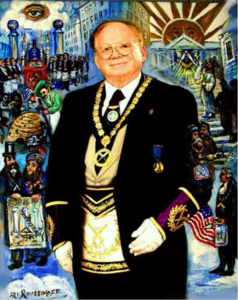
Next, I have the photo enlarged and transferred onto a canvas of the desired measurements.
The last step is for me to paint a complete composition surrounding the photo, which I do not alter. The painted elements will reflect elements in that person’s life or imagination.
Voila! Never an issue regarding likenesses. A Lodge commissioned me to do one of the retiring Grand Master of California. It was gifted him during a special presentation ceremony. And I did one as my personal gift for the retiring Grand Secretary of New York, a wonderful man.
By the way, these pictures are also made for non-masons. I’ve created them for weddings, anniversaries, births, people’s parents. Anything someone might like to have.
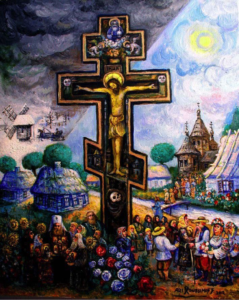
EL: I read that, for you, art is a spiritual experience. Would you share with us something about the process of bringing forth such wonderful images? Spiritually speaking, what is it that you experience?
AR: For me the act of painting is like praying.
It originates in my heart and my soul.
Spirituality in art is not limited to the confines of one or another religion. It is at the very core of all life.
Painting, like prayer, is a spiritual experience. Magical in many ways. And I am certain that being a painter is what God intended for me to be.
Otherwise I’d be doing other things. Too many people depend only on the limitations of their eyesight. They’re not able to touch base with the soul. Hence the four eyes in some of my paintings.
EL: I love your four eyes theme!
AR: In this self-portrait, the two pairs of eyes have a mystical meaning.
It is my belief that one should try to develop two sets of eyes.
One set represents our innermost self: the heart, passions and spirituality. This is the soul. The other set are those of the mind: logic and intellect. All four eyes together can give one excellent vision.
In art, it isn’t required that an artwork depict a religious subject in order to be spiritual. That special spirit is very much embedded within any true work of art. Spirituality can be felt in florals, landscapes, portraits, figurative or abstract compositions and whatever. Same holds true for music, literature and all other arts.
EL: On your website, linked here at the end of this interview, in addition to Masonic subjects, your art is presented in three other categories: Old Russia, Jewish life, Phantasmagoria.
AR: These are among the subjects I have painted throughout my life.
Art has been my lifelong passion. It is easiest to categorize works by subjects. There is also a general section called “Newest Works” featuring a cross section of paintings and also an interview. We are preparing to update the site. There are lots of new additions and improvements coming!
EL: I can’t wait to see what you’ll do next! You are also an award-winning director of motion pictures and have created sets for Broadway shows. You have done costume design, performance art, and have hosted a three-part television music program on MTV.
AR: All the arts are related. Being primarily visually oriented and a lover of classic movies, it had long been a desire to also express myself in film.
My first feature was a surrealist horror film featuring a cast of underground stars, even several Andy Warhol superstars. Federico Fellini, the brilliant Italian filmmaker, saw a rough edit of some of the early footage of bikers, and his admiration brought us further funding.
My best movie was the documentary Freaks Uncensored: A Human Sideshow which took years of research and dealt with the history of physical human anomalies throughout the ages. My significant other of many years Vivian Forlander wrote the screenplay and I directed it. It opened at the Anthology Film Archives in New York, to standing room only crowds and has been released on both VHS and DVD.
As for MTV, I hosted a special three-episode Russian style spoof of the MTV hits countdown. It was called MTV-ski and I was the Russian V-J, all dressed up in fur hat and rubaschka, peasant blouse. My old performance group went under the name “The Trans-Siberian Cossacks”, We performed in theaters, discos and art galleries.
As for the stage, I was chosen by impresario Ralph Mercado to create sets and paint a mural for an Eastern European show he was importing from Argentina.
“LIVE APPEARANCE AT NYC’S LIMELIGHT DISCO (1991)
Here I am on stage in 1991 with my old performance troupe “The Trans-Siberian Cossacks”. We are doing a live multi-media show at the Limelight Club in New York City. While our group lovingly exhibited Russian style, the name cossack was used metaphorically for individualism and inspired rebelliousness against status-quo trends (the initial meaning of cossack was rebel). We performed our uniquely circus-like shows in theaters, art galleries and discos. Venues ranged from the Limelight to Howard Guttenplan’s Millennium Film Workshop. This was a great way to incorporate elements of theater, painting, music and film. Cast members would often be interchangeable (based on locations). Performers included: Big Bob Bear, Clayton Patterson, Valerie Caris, Taylor Mead, The Magnificent Lori “W”, Vivi-Vixen and Brooks Rogers. In this photo at the Limelight, Clayton Patterson is the man holding the flag and the Queen of house music herself, Screamin’ Rachel is doing her wild thing in the far right, under the big screen (where we presented excerpts from one of my films).
It has been quite a few years now since I have retired “The Trans-Siberian Cossacks” (although occasionally, I get an urge to resurrect them). Even nowadays when giving a talk on my paintings, I like incorporating various elements. It makes for a more stimulating and also fun presentation.”
EL: In a way, the group has been resurrected in your work. Ari, what else would you like to mention that I didn’t ask?
AR: Just this week, I completed a Masonic composition which I call Pyramid Of Light.
Currently I am putting finishing touches to a painted apron. There are a multitude of paintings stored inside me, each competing against the others to make its way out and onto canvas first. And I haven’t a clue which one it will be. Freemasonry, with its great teachings of morality and positive energy, provide me with tremendous inspiration. I hope to do many paintings in that direction.
EL: The readers and I are hoping too, Ari, I am sure.
EL: Let’s end this interview with some of your amazing paintings. Thank you very much for letting us pick your brain. We would love to check-in with you periodically to let our readers know what you are up to.
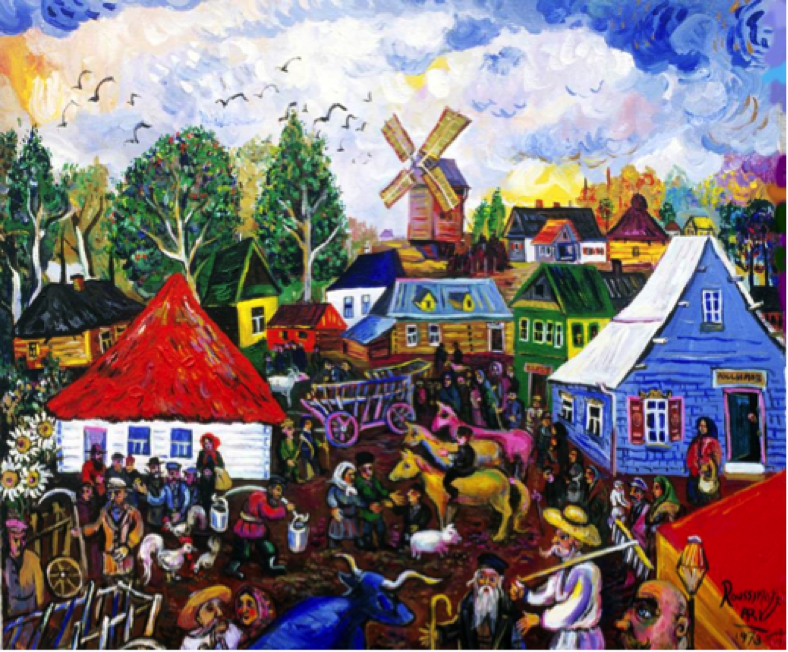
This is where all the action is: the Marketplace. Painted in 1973 and I added some finishing touches to it in 2003. Ari Roussimoff.

Here are fisherman doing what they love to do in an old Ukrainian or Russian village. One of my fun Cubist style paintings from 2004. I have always enjoyed watching fisherman at work, even though I do not eat sea food. Ari Roussimoff
You can find Ari Roussimoff work online at his website at http://roussimoff.com.

